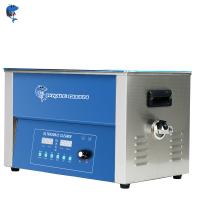6.5 Liter 150W Laboratory Ultrasonic Cleaner For Labware With 300W
Heater
What Can Whale Cleen sonic Offers?
Whale cleen offers a comprehensive line of Ultrasonic Cleaners,
from international factory China.
Ultrasonic cleaning is a powerful technique to remove tough
contaminants from parts immersed in aqueous media.
Diverse contaminants such as oil and grease, polishing media,
lapping abrasives, dirt etc. can easily be cleaned without damaging
the parts.
The whale cleen sonic Ultrasonic Cleaners use a special industrial
transducer that guarantees a homogeneous sound field distribution
and greatly improves the efficiency of the cleaning process.
In laboratory use the Ultrasonic Cleaners are used to clean
labware, to degas HPLC solvents and for mixing, dispersing and
emulsifying.
Data Sheet Of z-s031
| Model | Z-S031 |
| Tank Material | Stainless Steel 304 |
| Package | Carton Box |
| Tank size | 300x150x150mm |
| Unit size | 325x180x280mm |
| Carton packing Size | 410x255x355mm |
| Ultrasonic power range | 150W |
| timer | 0~30min Can Be Selected |
| Frequency | 40,000Hz |
| Tank capacity | 6.5L |
| pcs/carton | 1PCS/carton |
| N.W. | 5.5 kg |
| G.W. | 6.4 kg |
| Warranty | 1 year |
| Certificate | CE
|
Customer Cleaning Feedback:

Buying Guide:
Ultrasonic cleaners do a lot more than clean parts such as gears,
carburetors, PCB boards and surgical instruments. In the lab they
are broadly employed to degas solvents, disperse nanoparticles, and
emulsify, dissolve, disperse and otherwise prepare lab samples.
If you are cleaning parts, to get started you need to consider the
following before making a selection:
Type of contamination to be removed. There’s a big difference, as
you can imagine, between removing coolant from machined parts,
varnish deposits from a carburetor, ink from printing rolls, and
blood and tissue residues from surgical instruments.
The composition of products being cleaned. Different parameters
apply to cleaning aircraft engine components and glass capillaries.
You’ll need compatible cleaning solution and ultrasonic cleaning
frequency.
How will the parts be used after cleaning?
How do you define ‘clean’?
Will you be cleaning batches or individual parts?
Component size and weight
Once you define exactly what you’re trying to accomplish the
following points will help narrow down your equipment selection.
Then it’s time to contact Whale cleen sonic for specific
recommendations.
FAQ:
1. What is an Ultrasonic Transducer?
A transducer converts electrical energy at the ultrasonic frequency
to mechanical motion–sound. It directs the sound energy into the
cleaning tank.
2. What is Cavitation and Implosion?
The phenomenon of cavitation is unique in fluids. The cavitation
bubbles implode, releasing high energy locally. This implosion is
the heart of the ultrasonic process.














